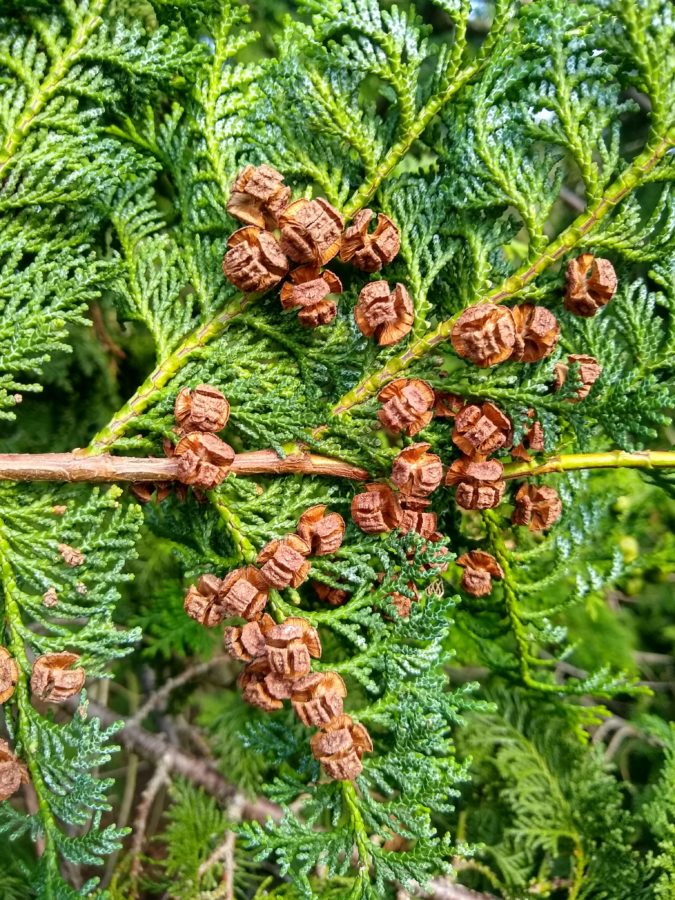Chamaecyparis obtusa Siebold & Zucc
(Hidayat, 2017)
Classification
Divisio: Pinophyta
Famili : Cupressaceae
Genus : Chamaecyparis
Species : Chamaecyparis obtusa
Common Name
Cemara Hias - Indonesia
Hinoki cypress (Missouri Botanical Garden) - asociated name
Hinoki false cypress (taxonomygrin) - English
Feuerscheinzypresse (taxonomygrin) - German
Hinoki cypress (Missouri Botanical Garden) - asociated name
Hinoki false cypress (taxonomygrin) - English
Feuerscheinzypresse (taxonomygrin) - German
Description
Chamaecyparis obtusa is native to Japan. It is commonly called hinoki cypress or hinoki falsecypress. It is an evergreen conifer that grows 50-75’ tall (to 120' tall in its native habitat) with a pyramidal shape. It features spreading branches with flattened horizontal branchlets that droop at the ends. Dark green scale-like leaves in two sizes have white markings beneath. Crushed foliage is aromatic. Reddish brown bark will peel on mature trees. Small, 8-scaled, greenish-brown (female) to orange brown (male) cones. Although species trees are uncommonly planted in the home landscape, a large number of compact and dwarf cultivars have become very popular for use as small accents/specimens, hedges, screens and foundation/rock garden plants.
Genus name comes from Greek chamai meaning dwarf or to the ground and kyparissos meaning cypress tree.
Specific epithet means rounded in reference to its leaves being blunt/rounded at the tips.
In Japan, hinoki means fire tree (Missouri Botanical Garden)
Genus name comes from Greek chamai meaning dwarf or to the ground and kyparissos meaning cypress tree.
Specific epithet means rounded in reference to its leaves being blunt/rounded at the tips.
In Japan, hinoki means fire tree (Missouri Botanical Garden)
The two varieties of this species occur in different
microhabitats: C. obtusa var. obtusa is generally occupying
more xeric sites on ridges or slopes; C. obtusa var. formosana can
form extensive forests in atmospherically damp and often edaphically wet sites.
Both occur in mixed conifer/angioserm forests, in which the conifers are mostly
emergents and the angiosperms form lower layers of canopy (Thomas 2019).
Description
Japan Korea and Far East, Taiwa Australia, New Caledonia, New Zealand, Southern America, and South Asia.
Habit
Tree
Benefit
Ornamental Plant.
The
wood of Chamaecyparis obtusa has been used for centuries in
construction of temples and other traditional buildings because of its fine quality
and high durability in outdoor conditions. The Japanese have largely turned to
sources outside Japan to obtain timber of related species, especially those
occurring on the Pacific coast of North America. This species is among the most
widely used in horticulture and numerous cultivars are in the trade (Thomas 2019).
Location at UPI
Other Pict.
 |
| (Hidayat, 2017) |

Male mature cones
Juniperus sp. L
 | |||
CemaraClassification
|
Common Name
Juniper
Red Cedar
Juniperus virgiana (source)
Description
The genus is characterized by fleshy cones with hard-shelled seeds, adaptations to avian seed dispersal; apart from this, all characters common to all of its species can also be found in other closely allied genera of Cupressaceae.
Habit
Tree
Distribution
North pole, Africs, Central America and Asia
Benefit
Ornamental Plant
Location at UPI
Other Pict.
 |
| Juniperus sp. L (Hidayat, 2017) |



No comments:
Post a Comment